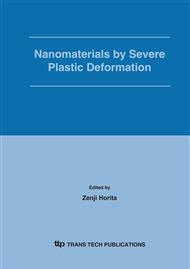p.3
p.11
p.19
p.25
p.31
p.37
p.45
p.51
p.57
Developing a Model for Grain Refinement in Equal-Channel Angular Pressing
Abstract:
It is now recognized that processing by equal-channel angular pressing (ECAP) leads to very significant grain refinement in polycrystalline materials with the as-pressed grains typically having sizes within the submicrometer range. Furthermore, the materials produced by ECAP exhibit many useful properties including a high strength at ambient temperatures and, if these ultrafine grains are retained to elevated temperatures, a potential for superplastic forming. This paper examines the fundamental characteristics of grain refinement by making use of two sets of experimental observations: experimental data obtained from the pressing of aluminum single crystals through one pass of ECAP and hardness measurements taken on polycrystalline aluminum for samples subjected to ECAP for up to a total of eight passes. These experimental results are used to develop a microstructural model that provides a satisfactory explanation for the grain refinement occurring in ECAP.
Info:
Periodical:
Pages:
19-24
Citation:
Online since:
January 2006
Authors:
Price:
Сopyright:
© 2006 Trans Tech Publications Ltd. All Rights Reserved
Share:
Citation:


